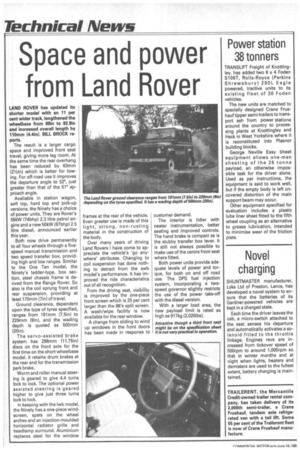Technical News
Page 18

If you've noticed an error in this article please click here to report it so we can fix it.
Space and power from Land Rover
LAND ROVER has updated its shorter model with an 11 per cent wider track, lengthened the wheelbase from 88in to 92.9in and increased overall length by 110mm (4.4in). BILL BROCK reports.
The result is a larger cargo space and improved front seat travel, giving more leg room. At the same time the rear overhang has been reduced by 63mm (21/2in) which is better for towing. For off-road use it improves the departure angle to 52°, just greater than that of the 51° approach angle.
Available in station wagon, soft top, hard top and pick-up versions, the Ninety has a choice of power units. They are Rover's 55kW (74bhp) 2.3 litre petrol engine and a new 50kW (67bhp) 2.5 litre diesel, announced earlier this year.
Both now drive permanently to all four wheels through a fivespeed manual transmission and two speed transfer box, providing high and low ranges. Similar to the One Ten model, the Ninety's ladder-type, box section, steel chassis frame is derived from the Range Rover. So also is the coil sprung front and rear suspension, providing at least 175mm (7in) of travel.
Ground clearance, dependent upon the type of tyres specified, ranges from 191mm (7.5in) to 229mm (91n), and the wading depth is quoted as 500mm (20m).
The servo-assisted brake system has 298mm (11.75in) discs on the front axle for the first time on the short wheelbase model. It retains drum brakes at the rear and for the transmission park brake.
Worm and roller manual steering is geared to give 4.4 turns lock to lock. The optional power assisted steering is geared higher to give just three turns lock to lock.
In keeping with the Iwb model, the Ninety has a one-piece windscreen, spats on the wheel arches and an injection-moulded horizontal radiator grille and headlamp surround. Aluminium replaces steel for the window frames at the rear of the vehicle. Even greater use is made of this light, strong, non-rusting material in the construction of the body.
Over many years of driving Land Rovers I have come to appreciate the vehicle's 'go anywhere' attributes. Changing to coil suspension has done nothing to detract from the swb model's performance. It has improved the ride characteristics out of all recognition.
From the driving seat, visibility is improved by the one-piece front screen which is 25 per cent larger than the 88's split screen. A wash/wipe facility is now available for the rear window.
A change from sliding to wind up windows in the front doors has been made in response to customer demand.
The interior is tidier with neater instrumentation, better seating and improved controls. The hand brake is compact as is the stubby transfer box lever. It is still not always possible to make use of the centre front seat where fitted.
Both power units provide adequate levels of power and torque, for both on and off road use. The DPS fuel injection system, incorporating a twospeed governor slightly restricts the use of the power take-off with the diesel version.
With a larger load area, the new payload limit is rated as high as 917kg (2,020lbs).
Attractive though a third front seat might be on the specification sheet it is not very practical in operation.




























































































